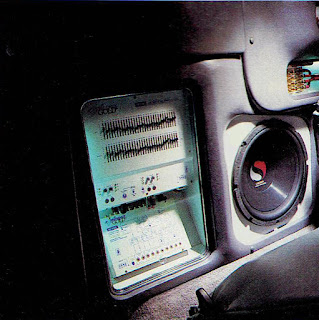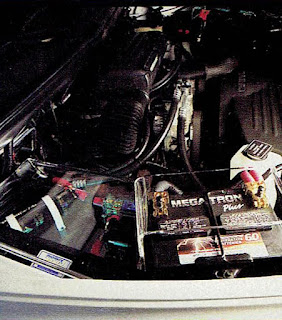But we should now prepare for the conclusion. This is what all the preparation was needed for. Very quickly, Jerry will address each speaker system from the most subjective angle in all the project: the listening experience. But why wait? Let's move on to the conclusion:
The Art of the Mid -Woofer;
11 Top Midbass Woofers Face-off!
(Part 2)
By Jerry Niebur
The Results
 |
| Hybrid Audio |
SCORING SYSTEM
The results of this test will be represented by a 4-Tier scoring system for the 11 drivers tested. Drivers in “Tier 1” scored the highest of the test group, while drivers in “Tier 4” scored the lowest of the test group.
The scores given to the mid-woofers in the individual categories determined the final tier placement for each driver. We will not divulge the actual scoring sheets.
The mid-woofers appear in alphabetical order in the tier in which they were placed. Technical data is presented at the end in alphabetical order by the manufacturer name.TIER 4 MID-WOOFERS
Eighteen Sound 6ND430
This company was started in Italy in 1997 and is a division of a much larger Italian company called AEB. AEB is involved in aquatics, alternative fuels, robotics, and well, you guessed it... drivers. It goes to show you that genius engineers of all types study speaker design; think about it, a speaker is an electro mechanical and magnetic device that also involves spring technology. This speaker features a neodymium magnet with an interesting surround, treated cone and a nice heat sink on the magnet assembly. It seems this baby was built for long-term abuse and sound reinforcement but their website clearly states “built for two way systems”.
These drivers finished in Tier 4 due to their poor overall performance relative to the other drivers in this test. All the testers were in consensus, stating these drivers were dead and lifeless sounding. Each tester also noted that these particular mid-woofers, while extending somewhat low, suffered from a lack of midbass impact and what they did play sounded muddy. They did not correctly replicate proper impact or loudness in varying textures of lower frequencies. The Eighteen Sound’s midrange sounded hollow and nasally, lacking a natural tonal quality. The overall presentation of music was substantially inferior to the other drivers in this test. Furthermore, the soundstage lacked depth, image placement, and lifelike presence.
There was no discernable difference of opinion between on-axis and off-axis testing. For these reasons, this woofer’s sonic performance was uninvolving. Consequently, these mid-woofers would be recommended for a different type of application.
 |
| Click Image to Enlarge |
SEAS EXCEL W18NX-001
The Seas Excel hails from Norway and Seas is a well known manufacturer of raw drivers designed for use in both home and car loudspeaker systems.
In this test they were also clearly in tier 4 with the Eighteen Sounds. The Seas Excel’s had a poor overall tonal balance. The listeners described the reproduction of the midrange frequencies as bright and brittle, and unanimously agreed these drivers exhibited a beaming quality in the upper midrange. These drivers generally lacked output and articulation in the lower midrange and midbass, sounding as if these frequencies were just missing. The sound of the Seas was so thin that many listeners thought the polarity had inadvertently been reversed. Unfortunately for the Seas, polarity was confirmed, and the drivers were indeed in phase. However, there is still the possibility of a technical issue with these particular drivers.
The testers also noted that these drivers were very dry and clinical sounding, lacking in musicality, validating the above characteristics. The Soundstage depth was considered poor and seemed to suffer from the overbearing high frequency information, causing the singer to get lost amongst the other instruments. Additionally, there was an inconsistency in the varying musical tracks on the top frequencies. Considering the performance of the other drivers in this test, these performed well below average. Given all the attributes at all frequencies, these drivers do not receive our recommendation as a top performance midbass and you are best served by another choice.
 |
| Click Image to Enlarge |
TIER 3 MID-WOOFERS
Audio Technology C-QUENZE 18H
The Audio Technology C-Quenze 18H is also manufactured in Denmark, along with the Dynaudio, Vifa and Scan-Speak brands. Drivers made by Audio Technology enjoy a prestigious pedigree; its founder is known for his experience and long history of loudspeaker design and innovation.
Surprisingly, relative to the other drivers in this test, these drivers faired only reasonably well, earning a Tier 3 rating. These mid-woofers lacked fullness to the midbass, especially in male vocals and varying drum tracks. In addition, articulation in the lower midrange lacked the finesse associated with a high quality driver. What midbass these drivers did have sounded a tad muddy and smeared. Where this speaker did do well was upper midrange, which is surprising considering it looks like a very heavy-duty driver; its robust stature would suggest incredible midbass impact, which was not the case. Interestingly, this driver performed well in the upper midrange. The presentation and staging also suffered due to the tonal inaccuracies in the lower registers. These drivers made the soundstage sound much smaller than it actually was, but the placement of images within the soundstage was reasonably well defined. Overall, these drivers were not impressive, and consequently, the sound was characterized as rather boring and uninvolving. It is noteworthy that Audio Technology offers customized products; you can actually tailor the Thiele/Small parameters and have them build a driver to your specifications, which is pretty cool.
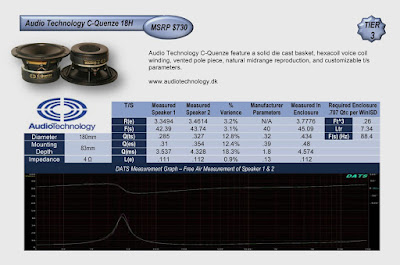 |
| Click Image to Enlarge |
JBL 660GTi
James B. Lansing founded JBL, which is now owned by Harmon International. JBL makes a variety of highly regarded products and has a vast history in speaker building. They are successful not only in the consumer market, but also in the professional and sound reinforcement. They have engineered a number of well-respected woofers using their own Aquaplas coating system and the Bi-Radial® horn-loaded drivers. During the early 1990's, they took much of what they had learned in the professional arena and applied it to their mobile products, creating what was known as the GTi series. Since then, the GTi line has grown into a full line of drivers. The JBL 660GTi midbass was designed to be the reference level mobile product.
Despite its lofty heritage, the 660 GTi was another woofer whose sonic performance was uninvolving enough to land it in Tier 3. Its overall presentation was mellow and what some judges reported as flat. Midbass frequencies sounded dull and lacked the impact of better scoring drivers.
With these drivers, drums lacked slam and sounded muddy. Like the Audio Technology, they had reasonably good upper mid-range detail and sounded best on acoustical guitar passages, but the low extension even on acoustic guitar was missing the necessary harmonics to move it up in the ranks. Overall, most instruments lacked life, sounding dull and emotionless. Nonetheless, the 660GTi’s exhibited reasonably good soundstage depth, height, and width. Due to its overall somewhat lacking overall performance, the judges unanimously agreed the JBL driver deserved a Tier 3 ranking.
 |
| Click Image to Enlarge |
Vifa NE180W-04
Vifa is also another brand hailing out of Denmark and has a long history of building drivers used in many DIY home audio kits. They manufacture a myriad of drivers with a wide range of parameters. This particular driver, like the Scan- Speak, uses a unique basket design allowing for welldirected airflow around the coil, while at the same time minimizing air turbulence from the spider-cone-magnet structure. This air turbulence, if not properly controlled and minimized, can create noise in the driver thus increasing audible distortion. Vifa and Scan-Speak have successfully developed their own technological approach to address the design challenges associated with turbulences. The driver’s cone also employs a unique geometry and wood pulp material developed by Vifa.
Even with all this technology, the Vifa NE180W-04 mid-woofers earned a Tier 3 ranking. This drivers exhibited poor low-frequency extension combined with inadequate midbass impact and heft. In more complicated passages, the midbass was further muddied and somewhat compressed sounding. Midrange frequencies also sounded harsh at times, sounding rather sharp and a bit beamy in the upper midrange. One common characteristic among Tier 3 woofers was the lack of articulation and involvement during playback; very dull from top to bottom. Its score on staging and imaging were VERY poor and one of the worst in the test. The testers unanimously agreed the stage depth was poor. The soundstage sounded rather one-dimensional with everything running together on a flat plane. This speaker could have been ranked in Tier 4, but the performance characteristics of the Tier 4 drivers were much worse than the Vifa.
 |
| Click Image to Enlarge |
TIER 2 MID-WOOFERS
Exodus Ex-Anarchy
The Exodus Ex-Anarchy mid-woofers came from a website that sells high-end cables named www.DIYcable.com. They are mostly a do-it-yourself website and the future for these drivers seems uncertain as per their website. From the website and the Exodus Audio data sheet, the driver appears to have been designed by Dan Wiggins at Acoustic Development International. This thing is a beast in both size and heft. The manufacturer claims significant midbass output, while minimizing associated turbulence and noises created from the mechanics of the driver. Given its commendable sonic performance at its affordable price point, this driver is undoubtedly the high value winner of this test. At $180 a pair, they are the bargain.
These mid-woofers scored well in the test. One of their best attributes was the even balance throughout the frequency range. As their beefy size might indicate, they excelled in midbass performance. The midbass had good impact, although it was a tad muddy, and at times, it sounded more like test tones than natural sounding midbass. Its midrange reproduction was good, although not impressive. There was some upper-end midrange resonance apparent during many of the songs especially during complex musical passages. Separation was poor throughout the entire frequency range, as many instruments and frequencies seemed to blend into one during the more demanding musical passages. The Exodus threw a large soundstage and scored well in height, depth, and width with all the testers. Overall, these drivers were solid performers and ranked well among the other drivers. As discussed in the “Ultimate Midrange Shootout”, a product like the Exodus, and a few others in this test, would greatly benefit from a dedicated midrange. In the midrange test, we had some high-value offerings that would compliment this driver quite well.
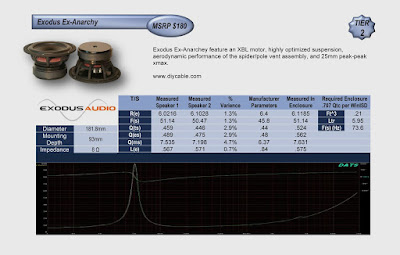 |
| Click Image to Enlarge |
Hybrid Audio Technologies L6SE
Hybrid Audio Technologies was founded in 2005 by Scott Buwalda, a multi-time champion in car audio sound quality competitions. The Hybrid Audio Technologies L6SE mid-woofers are the company’s top-of-the-line, reference-quality Special Edition. This gorgeous driver features a copper phase plug, a lightweight paper cone, and superb quality-related details.
This driver did many things well during this test. The midbass was detailed but didn’t quite match the superb impact and volume typical of Tier 1 drivers. The midbass frequencies simply needed more output and impact in the lower octaves. The female voices sounded airy and smooth, but the male voices sounded a little flat and lacked the visceral presentation of some of the higher scoring drivers. Instruments had good separation and the acoustic guitar sounded lively and palpable, due to its good midrange articulation and speed. These mid-woofers had great upper end detail and impact throughout the midrange frequencies, but at times sounded a bit strained. The main thing these drivers lacked was fullness to the sound, sounding accurate and correct, but falling short in the lower octaves. The testers unanimously agreed the soundstage was good, rendering it of proper size and height, depth, and width. The HAT L6SE overall performance was very good but just missing some presentation in lower octaves, sometimes sounding as if it would do better as a dedicated mid-range. In this test a great overall driver.
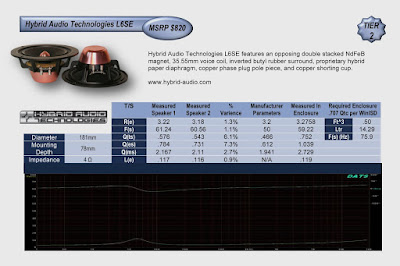 |
| Click Image to Enlarge |
Pioneer TS-C172PRS
Pioneer has long history of leadership in producing reference level mobile audio products. These mid-woofers are part of Pioneer’s newest Stage 4 reference level component set, which consists of mid-woofers, tweeters, and crossovers. Pioneer also offers a full electronic compliment (source unit and amplifier) as part of Stage 4. We are also very curious about their amplifiers [hmmm … future test? hint, hint].
The Pioneer TS-C172PRS mid-woofers sounded really nice overall with a pleasant balance throughout all frequencies. The lower bass capability was, like the Hybrids, lacking in the lower registers. The drivers did not have much low-frequency extension, and did get a little muddy down low, causing separation to suffer. The Pioneer’s midrange frequencies were also good, having wonderful detail in the upper frequencies. The Pioneer’s had threw a precise and reasonably large sound stage, with very good width, height, and width. These mid-woofers also scored well in the category of tonality. All testers were generally positive toward the Pioneer’s performance but they did fall short in bottom end resolution - clearly earning them a Tier 2 slot. Overall, another good sounding mid-woofer that just didn’t seem to extend very low and did not possess capabilities characteristic of the Tier 1 drivers.
 |
| Click Image to Enlarge |
TIER 1 MID-WOOFERS
Dynaudio Esotar2 e650
Dynaudio is fully engineered and manufactured in Denmark in their state-of-the-art facility. Dynaudio became famous for the performance and quality of their drivers that were, and still are, considered to be amongst the very best. Due to their reputation for performance and quality, Dynaudio drivers were used in many high-end speaker brands like Wilson Audio, Sonus Faber and Thiel, to name a few. Among Dynaudio’s many innovations in driver design, the most obvious is their proprietary magnesium silicate polymer cone, and their large, but lightweight, voice coil with internal magnets.
We tested the Esotar2 650, a mid-woofer from its flagship line of Esotar products.
Does all this extra effort in engineering, production and design pay off for Dynaudio? In a word YES. The Esotar2 650’s performed very well in this test with excellent extension in the lower registers. The midbass extension went very low, with very good midbass impact, articulation and detail. The performance in the midbass was effortless - even when going deep it still maintained its composure. Additionally, even in complex musical passages, the driver never strained. Midrange detail was exceptional, with subtleties much more noticeable throughout. Upper vocals sounded airy and natural, while lower vocals were strong and energetic, but still sounded true to life. Everything in a musical passage was played correctly and accurately. The actual descriptive comments from testers were – it‘s lifelike, non-fatiguing, full-bodied, and awesome. The overall soundstage was expansive and precise with excellent height, width and depth that created a 3-dimentional, almost holographic, soundstage with pinpoint images. Overall, this was an excellent sounding driver well deserving of its Tier 1 ranking.
 |
| Click Image to Enlarge |
PHASS MD0790
Phass is manufactured in Japan and first began as an amplifier company manufacturing a unique, but very serious, RE line of amplifiers. Their powerful solid-state amps utilize topology usually found in high-end tube amplifiers. At that time they offered two more high-end series amplifier families, one of which was the entry AP series which won a few awards and accolades for their performance. 1996 was the official beginning for Phass, and about a year later they began selling loudspeaker drivers.
The MD0790 is Phass’ top reference level offering and we are happy to report they have succeeded. This is a wonderful driver that utilizes a lightweight paper cone, high-density resin basket, and rare alnico magnet. These mid-woofers also scored very well in this test and ended up in the top tier. Tier 1 placement is impressive, as this company is more know for it high end amps [upcoming test? hint - details to be released]. The seriousness of this driver’s performance was immediately obvious. These mid-woofers sounded very full in their delivery, exhibiting very good low-end extension, with good impact in the lower mid-range frequencies. The driver’s deficit to the top two was due to its inability to convey the proper impact and drive like the Scan-Speak and Dynaudio. The Phass had good detail and separation throughout the entire passband, allowing the testers to easily hear the individual instruments. The midrange was pleasing and lifelike, and the stage presentation had good height, width, and depth, with good instrument separation and proper placement. The music played through the PHASS MD0790 is realistic sounding and tonally accurate. Well done!!
 |
| Click Image to Enlarge |
Scan-Speak 18WU/4741T-00
Scan-Speak, like Dynaudio, is one of the world’s premier loudspeaker manufactures and arguably one of the best. The company started production in 1970 and quickly became sought after because of the performance, low distortion and quality construction. Designed and manufactured in Denmark,
Scan-Speak is known worldwide for its careful manufacturing and quality control. You will find that Scan-Speak also has some automotive offerings but for this test we wanted the best from their Illuminator product line.
The Scan-Speak 18WU’s midbass performance was also stellar, earning a Tier 1 placement. Its performance in these lower registers was also effortless and clean. It was punchy and authoritative when it needed to be, and gently refined when the music called for those subtleties. Like the other two in this tier you can keep on listening, it was tonally right. The midrange was also amazing with tremendous timbral accuracy, and an appropriate sense of air. The only nitpick was absence of upper-end detail. Other than that, this was one of the top performing drivers of the test. The soundstage was precise and three-dimensional, with incredible height, width, and depth that made the stage came alive with well-separated instruments and vocals.
These drivers had good detail throughout most of the passband with a very nice, rich texture. These mid-woofers were full of energy and presence, while sounding tonally accurate and lifelike. Overall, this was a superb sounding mid-woofer that did almost everything right.
 |
| Click Image to Enlarge |
CONCLUSION
“High performance” or “reference” is thrown around too easily these days and those designations seem to be driven more by marketing than solid engineering and superior build quality. Further confusing the decision process can be the vast information available on the internet. While the internet serves as an excellent starting guideline for product research, it is also filled with unverifiable verdicts and opinions. We were resolute in our unbiased testing to find superior performing midbass drivers. As always, consider your own priorities, installation limits, and goals. “Tier 1” placement was reserved for drivers that played effortlessly and accurately while still maintaining their midrange resolution even at realistic volume levels. Overall this placement is reserved for outstanding performance with majority consensus amongst the judges. Any driver in “Tier 1” will reward with exceptional performance. “Tier 2” drivers are an excellent option and should still be considered. Drivers in this group did everything well but have a shortcoming to “Tier 1” drivers. The products in “Tier 3” have some good characteristics but were lacking in numerous performance variables as compared to the top two tiers. “Tier 3” drivers, and even in some instances “Tier 2” drivers, would gain performance with the addition of a dedicated midrange. It was the opinion of all the judges that “Tier 4” was not in the same caliber as the other drivers and were not to be considered. The Seas drivers in this test could have had some defect given their poor results, but given the time constraints we could not verify this. The Eighteen Sounds seems to have been designed for another purpose other than a dedicated midbass for two-way system duties.
 |
| Click Image to Enlarge |
Using these bar graphs, further visual guidance is quickly given on the performance of these drivers in this test. This section shows that some specified data doesn’t correlate to expected performance especially in the lower octaves. Considering the ultimate goal for these drivers is a mobile installation, special consideration must be made to mounting depth. If your desire is to build dedicated door enclosures our graph shows which drivers work best in the smallest enclosures. Even if you choose to mount your drivers in "free air", our graph helps you select drivers designed to perform best for that application.
While there is no such thing as the perfect speaker, there are some that are far better than others: some that put a big smile on your face, some that made you wince once and a while, and some that made you question logic and intelligence - we wanted big smiles……we got them!
For any questions or comments, please email me at jerry_hdma@cox.net.
" ... loudspeaker design is still largely an art. Engineering will guide the way, but it is no substitute for good taste, good sense, and musical sensitivity. If Engineering were all it took, there would be no bad or even mediocre loudspeakers to think about." (5)
 |
| Hybrid, Dynaudio & PHASS |
Reference
(1) V. Dickason, The Loudspeaker Design Cookbook, 6th Ed., Audio Amateur Press, ©2000, pp. 23-32, 155-171.
(2) H. J. Weibell and R. Bywater, Practical Design of Optimal Sealed-Box Loudspeaker Systems, Audio Engineering Society, reprint 2105 (C-2), 1984.
(3) V. Dickason, The Loudspeaker Design Cookbook, 6th Ed., Audio Amateur Press, ©2000, pp. 173-183.
(4) Ibid. p. 33.
(5) Vance Dickason, The Loudspeaker Design Cookbook, 6th ed., 2000, p. 155.
(6) V. Dickason, The Loudspeaker Design Cookbook, 6th Ed., Audio Amateur Press, ©2000, p. 105.
(7) http://www.diyaudio.com/forums/multi-way/192215-phase-plug.html
*The above illustrates and supports your editors’ findings and conclusions derived from the “The Ultimate Midrange Shootout”.

















